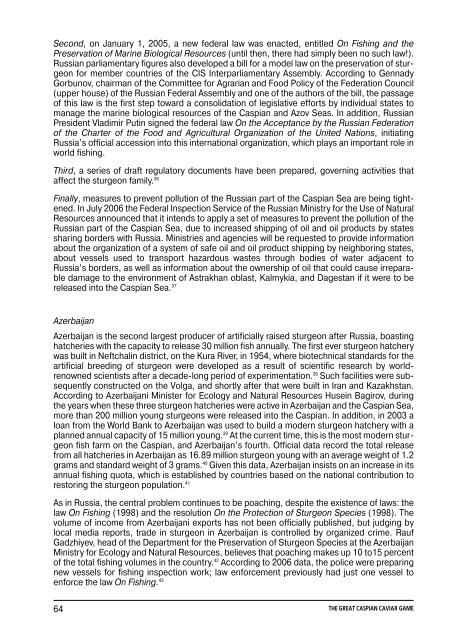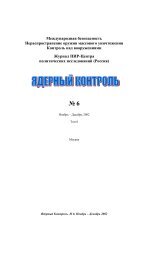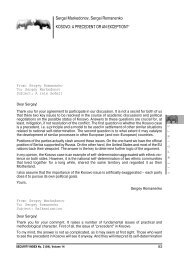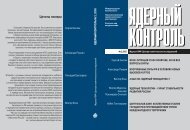Ekaterina Shadrina THE GREAT CASPIAN CAVIAR GAME
Ekaterina Shadrina THE GREAT CASPIAN CAVIAR GAME
Ekaterina Shadrina THE GREAT CASPIAN CAVIAR GAME
Create successful ePaper yourself
Turn your PDF publications into a flip-book with our unique Google optimized e-Paper software.
Second, on January 1, 2005, a new federal law was enacted, entitled On Fishing and the<br />
Preservation of Marine Biological Resources (until then, there had simply been no such law!).<br />
Russian parliamentary figures also developed a bill for a model law on the preservation of sturgeon<br />
for member countries of the CIS Interparliamentary Assembly. According to Gennady<br />
Gorbunov, chairman of the Committee for Agrarian and Food Policy of the Federation Council<br />
(upper house) of the Russian Federal Assembly and one of the authors of the bill, the passage<br />
of this law is the first step toward a consolidation of legislative efforts by individual states to<br />
manage the marine biological resources of the Caspian and Azov Seas. In addition, Russian<br />
President Vladimir Putin signed the federal law On the Acceptance by the Russian Federation<br />
of the Charter of the Food and Agricultural Organization of the United Nations, initiating<br />
Russia’s official accession into this international organization, which plays an important role in<br />
world fishing.<br />
Third, a series of draft regulatory documents have been prepared, governing activities that<br />
affect the sturgeon family. 36<br />
Finally, measures to prevent pollution of the Russian part of the Caspian Sea are being tightened.<br />
In July 2006 the Federal Inspection Service of the Russian Ministry for the Use of Natural<br />
Resources announced that it intends to apply a set of measures to prevent the pollution of the<br />
Russian part of the Caspian Sea, due to increased shipping of oil and oil products by states<br />
sharing borders with Russia. Ministries and agencies will be requested to provide information<br />
about the organization of a system of safe oil and oil product shipping by neighboring states,<br />
about vessels used to transport hazardous wastes through bodies of water adjacent to<br />
Russia’s borders, as well as information about the ownership of oil that could cause irreparable<br />
damage to the environment of Astrakhan oblast, Kalmykia, and Dagestan if it were to be<br />
released into the Caspian Sea. 37<br />
Azerbaijan<br />
Azerbaijan is the second largest producer of artificially raised sturgeon after Russia, boasting<br />
hatcheries with the capacity to release 30 million fish annually. The first ever sturgeon hatchery<br />
was built in Neftchalin district, on the Kura River, in 1954, where biotechnical standards for the<br />
artificial breeding of sturgeon were developed as a result of scientific research by worldrenowned<br />
scientists after a decade-long period of experimentation. 38 Such facilities were subsequently<br />
constructed on the Volga, and shortly after that were built in Iran and Kazakhstan.<br />
According to Azerbaijani Minister for Ecology and Natural Resources Husein Bagirov, during<br />
the years when these three sturgeon hatcheries were active in Azerbaijan and the Caspian Sea,<br />
more than 200 million young sturgeons were released into the Caspian. In addition, in 2003 a<br />
loan from the World Bank to Azerbaijan was used to build a modern sturgeon hatchery with a<br />
planned annual capacity of 15 million young. 39 At the current time, this is the most modern sturgeon<br />
fish farm on the Caspian, and Azerbaijan’s fourth. Official data record the total release<br />
from all hatcheries in Azerbaijan as 16.89 million sturgeon young with an average weight of 1.2<br />
grams and standard weight of 3 grams. 40 Given this data, Azerbaijan insists on an increase in its<br />
annual fishing quota, which is established by countries based on the national contribution to<br />
restoring the sturgeon population. 41<br />
As in Russia, the central problem continues to be poaching, despite the existence of laws: the<br />
law On Fishing (1998) and the resolution On the Protection of Sturgeon Species (1998). The<br />
volume of income from Azerbaijani exports has not been officially published, but judging by<br />
local media reports, trade in sturgeon in Azerbaijan is controlled by organized crime. Rauf<br />
Gadzhiyev, head of the Department for the Preservation of Sturgeon Species at the Azerbaijan<br />
Ministry for Ecology and Natural Resources, believes that poaching makes up 10 to15 percent<br />
of the total fishing volumes in the country. 42 According to 2006 data, the police were preparing<br />
new vessels for fishing inspection work; law enforcement previously had just one vessel to<br />
enforce the law On Fishing. 43<br />
64 <strong>THE</strong> <strong>GREAT</strong> <strong>CASPIAN</strong> <strong>CAVIAR</strong> <strong>GAME</strong>








